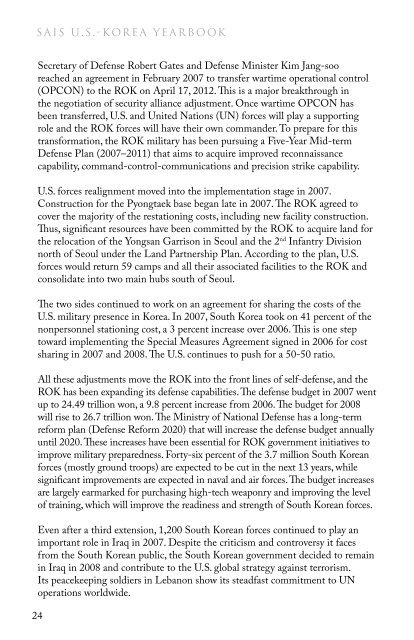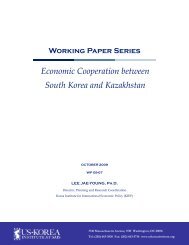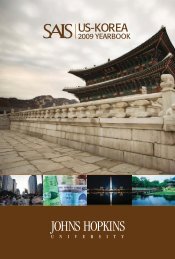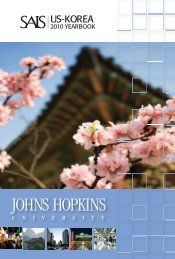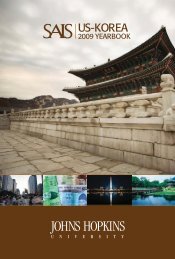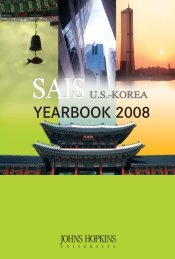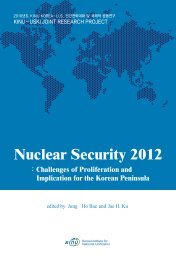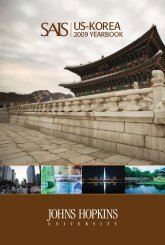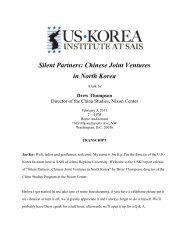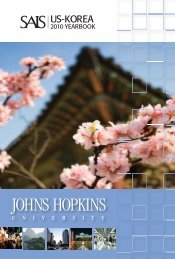YeArBooK 2007 - US-Korea Institute at SAIS
YeArBooK 2007 - US-Korea Institute at SAIS
YeArBooK 2007 - US-Korea Institute at SAIS
You also want an ePaper? Increase the reach of your titles
YUMPU automatically turns print PDFs into web optimized ePapers that Google loves.
saIs U.s.-<strong>Korea</strong> YearbooK<br />
Secretary of Defense Robert G<strong>at</strong>es and Defense Minister Kim Jang-soo<br />
reached an agreement in February <strong>2007</strong> to transfer wartime oper<strong>at</strong>ional control<br />
(OPCON) to the ROK on April 17, 2012. This is a major breakthrough in<br />
the negoti<strong>at</strong>ion of security alliance adjustment. Once wartime OPCON has<br />
been transferred, U.S. and United N<strong>at</strong>ions (UN) forces will play a supporting<br />
role and the ROK forces will have their own commander. To prepare for this<br />
transform<strong>at</strong>ion, the ROK military has been pursuing a Five-Year Mid-term<br />
Defense Plan (<strong>2007</strong>–2011) th<strong>at</strong> aims to acquire improved reconnaissance<br />
capability, command-control-communic<strong>at</strong>ions and precision strike capability.<br />
U.S. forces realignment moved into the implement<strong>at</strong>ion stage in <strong>2007</strong>.<br />
Construction for the Pyongtaek base began l<strong>at</strong>e in <strong>2007</strong>. The ROK agreed to<br />
cover the majority of the rest<strong>at</strong>ioning costs, including new facility construction.<br />
Thus, significant resources have been committed by the ROK to acquire land for<br />
the reloc<strong>at</strong>ion of the Yongsan Garrison in Seoul and the 2 nd Infantry Division<br />
north of Seoul under the Land Partnership Plan. According to the plan, U.S.<br />
forces would return 59 camps and all their associ<strong>at</strong>ed facilities to the ROK and<br />
consolid<strong>at</strong>e into two main hubs south of Seoul.<br />
The two sides continued to work on an agreement for sharing the costs of the<br />
U.S. military presence in <strong>Korea</strong>. In <strong>2007</strong>, South <strong>Korea</strong> took on 41 percent of the<br />
nonpersonnel st<strong>at</strong>ioning cost, a 3 percent increase over 2006. This is one step<br />
toward implementing the Special Measures Agreement signed in 2006 for cost<br />
sharing in <strong>2007</strong> and 2008. The U.S. continues to push for a 50-50 r<strong>at</strong>io.<br />
All these adjustments move the ROK into the front lines of self-defense, and the<br />
ROK has been expanding its defense capabilities. The defense budget in <strong>2007</strong> went<br />
up to 24.49 trillion won, a 9.8 percent increase from 2006. The budget for 2008<br />
will rise to 26.7 trillion won. The Ministry of N<strong>at</strong>ional Defense has a long-term<br />
reform plan (Defense Reform 2020) th<strong>at</strong> will increase the defense budget annually<br />
until 2020. These increases have been essential for ROK government initi<strong>at</strong>ives to<br />
improve military preparedness. Forty-six percent of the 3.7 million South <strong>Korea</strong>n<br />
forces (mostly ground troops) are expected to be cut in the next 13 years, while<br />
significant improvements are expected in naval and air forces. The budget increases<br />
are largely earmarked for purchasing high-tech weaponry and improving the level<br />
of training, which will improve the readiness and strength of South <strong>Korea</strong>n forces.<br />
Even after a third extension, 1,200 South <strong>Korea</strong>n forces continued to play an<br />
important role in Iraq in <strong>2007</strong>. Despite the criticism and controversy it faces<br />
from the South <strong>Korea</strong>n public, the South <strong>Korea</strong>n government decided to remain<br />
in Iraq in 2008 and contribute to the U.S. global str<strong>at</strong>egy against terrorism.<br />
Its peacekeeping soldiers in Lebanon show its steadfast commitment to UN<br />
oper<strong>at</strong>ions worldwide.<br />
24<br />
U.s.-roK allIanCe: looKInG ToWard THe fUTUre<br />
All the progress in <strong>2007</strong> represents a stable adjustment of the military alliance.<br />
The global situ<strong>at</strong>ion has been changing rapidly since the end of the Cold War,<br />
and the str<strong>at</strong>egic and security concerns of the U.S.-ROK alliance have changed<br />
accordingly. The Soviet Union no longer exists as the biggest thre<strong>at</strong> to the U.S.;<br />
nor does North <strong>Korea</strong> represent the largest and most direct thre<strong>at</strong> to South<br />
<strong>Korea</strong>. Crucial security problems such as the North <strong>Korea</strong>n nuclear issue are<br />
being tackled in a multil<strong>at</strong>eral venue, and bil<strong>at</strong>eral military alliances must adjust<br />
to the changing environment. With its strong economy and impressive cultural,<br />
political and social achievements, South <strong>Korea</strong> n<strong>at</strong>urally seeks to regain control<br />
of its own military. The strong U.S. military command made sense when South<br />
<strong>Korea</strong> was weak and vulnerable to a North <strong>Korea</strong>n <strong>at</strong>tack; however, to eventually<br />
become a genuinely self-sufficient n<strong>at</strong>ion, it should have control over its own<br />
military. Now is a good time to make this important adjustment, because South<br />
<strong>Korea</strong> is strong enough to assume gre<strong>at</strong>er responsibility and the global str<strong>at</strong>egic<br />
concerns facing the U.S. make it more important for South <strong>Korea</strong> to take a<br />
leading role in its own defense. The agreement during the SCAP meetings in<br />
2006 underscores the str<strong>at</strong>egic change in the alliance members’ priorities: “The<br />
Republic of <strong>Korea</strong> supports the str<strong>at</strong>egic flexibility of the United St<strong>at</strong>es forces<br />
in <strong>Korea</strong>, and the United St<strong>at</strong>es respects the Republic of <strong>Korea</strong>’s position th<strong>at</strong> it<br />
shall not be involved in a regional conflict against the <strong>Korea</strong>n people’s will.”<br />
Regarding the reloc<strong>at</strong>ion of U.S. forces to positions south of Seoul, some people see it<br />
as an unfriendly gesture from South <strong>Korea</strong> and the beginning of a U.S. pullout. But it<br />
is superficial to think this way. First, the area in downtown Seoul th<strong>at</strong> U.S. forces have<br />
occupied is very precious urban land. No one would welcome a large military presence<br />
in the middle of Manh<strong>at</strong>tan. And moving the 2 nd Infantry Division farther away from<br />
the DMZ does not mean th<strong>at</strong> the U.S. is less committed to the defense of South<br />
<strong>Korea</strong>. One clear shift in the U.S. global defense str<strong>at</strong>egy is to improve the flexibility<br />
and mobility of its forces. A significant amount of energy has gone into building a<br />
strong U.S. naval and air presence on the <strong>Korea</strong>n peninsula. Concentr<strong>at</strong>ing U.S. forces<br />
in the south helps further th<strong>at</strong> goal and fits into the str<strong>at</strong>egic shift of U.S. forces playing<br />
a supporting role in South <strong>Korea</strong>’s self-defense. The ROK has more than a million<br />
ground forces concentr<strong>at</strong>ed on its northern border.<br />
There are also some practical reasons for this move. More than 60 percent of the<br />
U.S. troops in <strong>Korea</strong> are married, and the U.S. commander is trying to extend the<br />
tour of duty from one year to three years so their families can accompany them.<br />
Realignment offers a chance to upgrade facilities and provide more space for the<br />
soldiers and their families. With longer tours and the presence of their families,<br />
the U.S. troops would enjoy a higher quality of life and more easily integr<strong>at</strong>e into<br />
the local <strong>Korea</strong>n society.<br />
25


